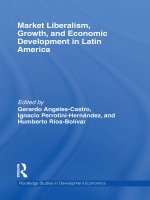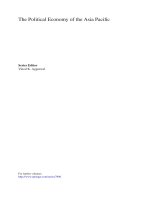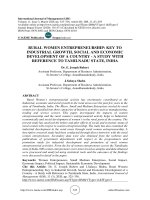Economic growth and economic development 571
Bạn đang xem bản rút gọn của tài liệu. Xem và tải ngay bản đầy đủ của tài liệu tại đây (146.78 KB, 1 trang )
Introduction to Modern Economic Growth
This first-order condition for the consumption index immediately implies that (see
Exercise 12.10):
P ≡
(12.9)
ÃN
X
i=1
p1−ε
i
1
! 1−ε
.
Since P is the price index corresponding to the consumption index C, it is typically
referred to as the ideal price index, and in many circumstances, it will be convenient
to choose this ideal price index as the numeraire. Note, however, that we cannot
set this as the price index in this particular instance, since we have already written
the budget constraint in terms of money income, m, and also normalized the price
of good y to 1.
In addition, the choice between C and y is also facilitated in this case, and boils
down to the maximization of a semi-indirect utility function
U (C, y) = C + v (y) ,
where we have use the definition of the consumption index C. Similarly, combining
(12.8) and (12.9) with the budget constraint, (12.7), we obtain a budget constraint
expressed in terms of C and y,
P C + y ≤ m.
Now the maximization of this semi-indirect utility function would respect to this
budget constraint yields the following first-order condition:
1
v0 (y) = ,
P
which assumes that the solution is interior, an assumption we maintain throughout
to simplify the discussion.
Since v (·) is strictly concave, v 0 (·) is strictly decreasing and can be inverted, so
that we obtain
(12.10)
à ả
1
y = v
P
à ả
1
01
C = mv
.
P
01
Next, let us consider the production of the varieties. Suppose that each variety
can only be produced by a single firm, who is thus an effective monopolist for this
557









